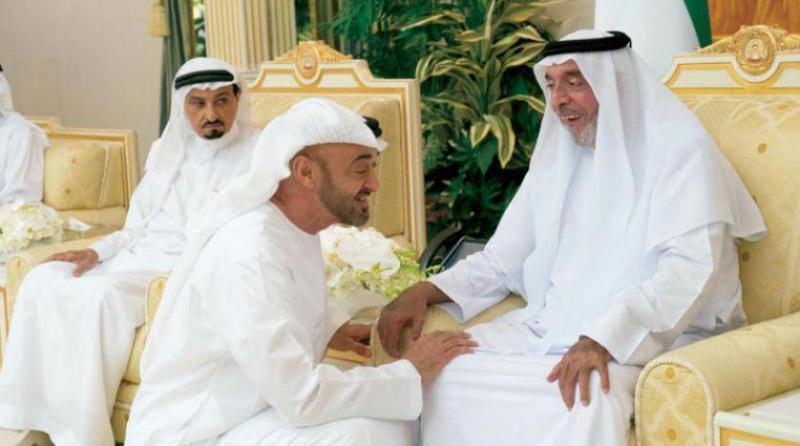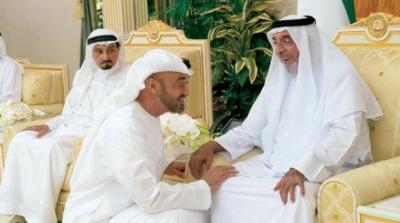The late Sheikh Khalifa bin Zayed Al Nahyan, the eldest son of the founder of the United Arab Emirates, Sheikh Zayed bin Sultan Al Nahyan - may God have mercy on him - was the second president of the country after his father. He was elected as the president of the Gulf state on November 3, 2004, following the establishment of the UAE on December 2, 1971. His mother is Sheikha Hissa bint Mohammed bin Khalifa bin Zayed Al Nahyan. He was born on September 7, 1948, in Al Muwaiji Fort in the city of Al Ain, which belongs to the Emirate of Abu Dhabi, the capital of the country. He lived with his family in the same fort, where he received his schooling at the Al Nahyan School established by Sheikh Zayed. He spent most of his childhood in the oases of Al Ain and Al Buraimi alongside his father, who governed the Al Ain area at that time. Sheikh Khalifa kept close to his father, Sheikh Zayed bin Sultan Al Nahyan - may God have mercy on him - in his mission to improve the lives of tribes in the region and to establish state authority, which had a significant impact on his education, as he also attended public councils.
He was appointed as the representative of the Ruler of Abu Dhabi in the Eastern Region and president of its legal system in August 1966. He was appointed Crown Prince of the Emirate of Abu Dhabi on February 1, 1969, and he became the head of the first local council of ministers for the Emirate of Abu Dhabi on July 1, 1971, in addition to holding the Defense and Finance portfolios in that council. He became Deputy Prime Minister of the Federal Council on January 20, 1974, and then Deputy Supreme Commander of the Armed Forces of the UAE in 1976.
When Sheikh Zayed Al Nahyan moved to Abu Dhabi to become the Ruler of the Emirate in August 1966, he appointed his son Sheikh Khalifa - then 18 years old - as his representative in the Eastern Region and head of its courts. This delegation was considered evidence of his father's trust in him. On February 1, 1969, Sheikh Khalifa was appointed Crown Prince of the Emirate of Abu Dhabi. The following day, he undertook the responsibilities of the Defense Department in the emirate, establishing it as the nucleus for what would become the armed forces of the UAE. On July 1, 1971, amid a restructuring of the Abu Dhabi government, he was appointed Ruler of Abu Dhabi and a minister for defense and finance in the emirate.
On December 23, 1973, Sheikh Khalifa took the position of Deputy Prime Minister in the second cabinet. Shortly thereafter, on January 20, 1974, he assumed the presidency of the Executive Council for the Emirate of Abu Dhabi, which replaced the local government in the emirate. Sheikh Khalifa bin Zayed oversaw the Executive Council in achieving comprehensive development programs in the Emirate of Abu Dhabi, instructing the establishment of the Abu Dhabi Investment Authority in 1976, aimed at managing financial investments in the emirate to ensure a steady source of income for future generations. Khalifa bin Zayed was elected president of the state on November 3, 2004, following the death of his father, Sheikh Zayed bin Sultan Al Nahyan, on November 2, 2004.
Sheikh Khalifa was known for his various hobbies, including fishing and falconry, which reflected his diverse interests, particularly through his support for several environmental projects, including programs for breeding and releasing falcons and houbara birds in the Arabian Peninsula and Central Asia. He appointed a minister for the environment in the first government formed during his reign. Sheikh Khalifa was also a sports enthusiast and had additional interests in literature and history.
Under his leadership, the country witnessed extensive developmental progress. In 2005, Sheikh Khalifa bin Zayed ordered the implementation of comprehensive infrastructure projects across the country, allocating 16 billion dirhams (4.3 billion dollars) for the development of infrastructure and service facilities in the northern emirates to catalyze economic and social advancement in these areas, keeping pace with the development witnessed by other emirates. By 2013, over 24 ports were completed, Sheikh Khalifa Hospital was built in Ras Al Khaimah, thousands of houses were constructed, alongside several highways, intersections, and tunnels.
His reign marked the beginning of the empowerment journey in 2006 with the establishment of the Federal National Council, an advisory council comprising 40 members, including women. He organized the first electoral process that year to engage citizens in the political process and contribute to shaping their future and that of future generations.
Sheikh Khalifa bin Zayed's foreign policy witnessed a balance in relations with countries in the region and around the world, with the UAE working to elevate dealings with nations to levels of comprehensive partnership and strengthening ties with GCC and Arab states, in addition to the historic event of the UAE and Israel agreeing to establish full bilateral relations.
Sheikh Mohammed bin Rashid Al Maktoum, Vice President of the UAE and Prime Minister, named the tallest building in the world after Sheikh Khalifa bin Zayed Al Nahyan, which was initially intended to be called Burj Dubai. At that time, Sheikh Mohammed bin Rashid stated, “Every valuable point in the world must be associated with a great name and personality, and I announce now the opening of Burj Khalifa bin Zayed as the tallest man-made skyscraper,” which occurred in 2010. Sheikh Khalifa bin Zayed suffered a health setback due to a stroke at the end of January 2014.




